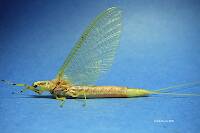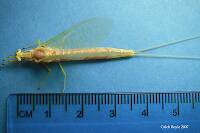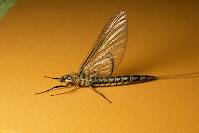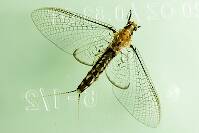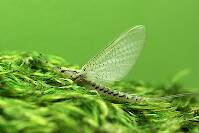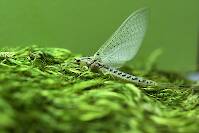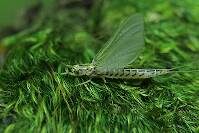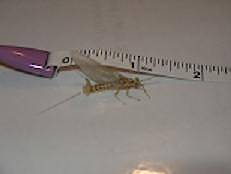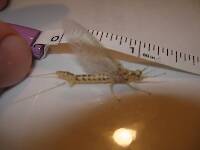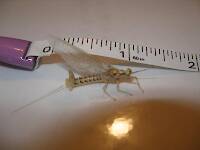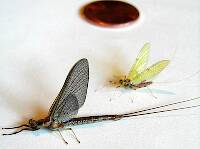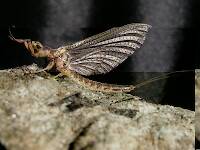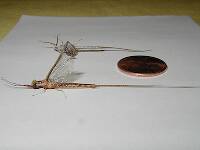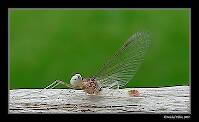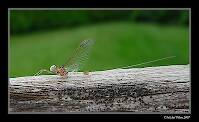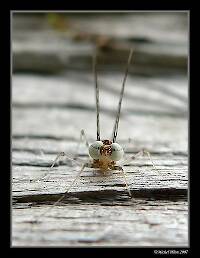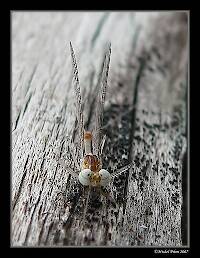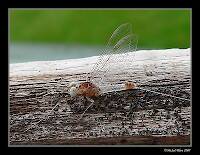
Hex Mayflies
Hexagenia limbata
The famous nocturnal Hex hatch of the Midwest (and a few other lucky locations) stirs to the surface mythically large brown trout that only touch streamers for the rest of the year.
Featured on the forum

It's only barely visible in one of my pictures, but I confirmed under the microscope that this one has a prosternal horn and the antennae are mid-way between the eyes and front of the head capsule.
I'm calling this one Pycnopsyche, but it's a bit perplexing. It seems to key definitively to at least Couplet 8 of the Key to Genera of Limnephilidae Larvae. That narrows it down to three genera, and the case seems wrong for the other two. The case looks right for Pycnopsyche, and it fits one of the key characteristics: "Abdominal sternum II without chloride epithelium and abdominal segment IX with only single seta on each side of dorsal sclerite." However, the characteristic "metanotal sa1 sclerites not fused, although often contiguous" does not seem to fit well. Those sclerites sure look fused to me, although I can make out a thin groove in the touching halves in the anterior half under the microscope. Perhaps this is a regional variation.
The only species of Pycnopsyche documented in Washington state is Pycnopsyche guttifera, and the colors and markings around the head of this specimen seem to match very well a specimen of that species from Massachusetts on Bugguide. So I am placing it in that species for now.
Whatever species this is, I photographed another specimen of seemingly the same species from the same spot a couple months later.
I'm calling this one Pycnopsyche, but it's a bit perplexing. It seems to key definitively to at least Couplet 8 of the Key to Genera of Limnephilidae Larvae. That narrows it down to three genera, and the case seems wrong for the other two. The case looks right for Pycnopsyche, and it fits one of the key characteristics: "Abdominal sternum II without chloride epithelium and abdominal segment IX with only single seta on each side of dorsal sclerite." However, the characteristic "metanotal sa1 sclerites not fused, although often contiguous" does not seem to fit well. Those sclerites sure look fused to me, although I can make out a thin groove in the touching halves in the anterior half under the microscope. Perhaps this is a regional variation.
The only species of Pycnopsyche documented in Washington state is Pycnopsyche guttifera, and the colors and markings around the head of this specimen seem to match very well a specimen of that species from Massachusetts on Bugguide. So I am placing it in that species for now.
Whatever species this is, I photographed another specimen of seemingly the same species from the same spot a couple months later.

Troutnut is a project started in 2003 by salmonid ecologist Jason "Troutnut" Neuswanger to help anglers and
fly tyers unabashedly embrace the entomological side of the sport. Learn more about Troutnut or
support the project for an enhanced experience here.
Troutnut on Mar 1, 2012March 1st, 2012, 6:35 pm EST
3. Ok, if it's Hexagenia, which species is it? Of the three species reported from Quebec, H. bilineata can be eliminated over the lack of markings that appear as longitudinal striping in the hand. Of the two remaining, rigida is noted for its obvious yellow dorsal triangles, while limbata is noted for its high degree of variability and is by far the most common. Based on this I would say the specimen is most likely the latter. What is really interesting about the lateral photos is they show chevron markings pointing towards the thorax, which is very unusual. They normally point to the tails.
My opinion as to species? Hexagenia limbata.
How about Hexagenia atrocaudata? It looks extremely similar to my female dun of that species, including the direction of the chevron markings, and the darkness on the margins of the hind wings. They might not be recorded yet in Quebec, but they're broadly distributed in the USA nearby and it would be surprising if they aren't there, too.
What's strange is the presence of any of these species as adults in early May... but stranger things have happened. I guess atrocaudata would be especially strange since I've always seen them in late August, over a month after limbata. But if this individual has really weird timing for some reason, maybe it could still be either one.
Jason Neuswanger, Ph.D.
Troutnut and salmonid ecologist
Troutnut and salmonid ecologist
Entoman on Mar 1, 2012March 1st, 2012, 9:12 pm EST
I noticed the similarity too, Jason. In fact, I stared at those photo's of yours quite a bit. :) It's a closer match than any example of Limbata I have found so far and the similarity is pretty obvious in more ways than just the chevrons. But the emergence date throws me off as well which is why I speculated Litobrancha with the first few photo's.
I just had difficulty reconciling the documentation. Both Mayflies of North and Central America, G. Edmunds 1976 and Burrowing Mayflies (Ephemeroptera: Ephemeroidea) of the United States, Mccafferty 1975 (supplemented & updated in 1994), list atrocaudata's northern distribution as basically ringing the Great Lakes with Ontario to the North, WI to the West and western NY to the East. It is not listed for Quebec or any of the New England states. This is further corroborated by the more recent Distribution of Mayfly Species of North America, by R. P. Randolph. There are also a plethora of various papers that are state or region specific and none of them that I have found list atrocaudata in NE or QB. In the face of this mound of evidence and the incredible variations Limbata is capable of (especially after Michel disclosed this animal was captured near the VT border and that it was "very big"), I went with limbata.
Perhaps I'm placing too much emphasis on distribution lists. Also, the definition of "very big" is relative. Michel, was the length of this fly (from head to tip of abdomen) closer to 20mm or 40mm?
I just had difficulty reconciling the documentation. Both Mayflies of North and Central America, G. Edmunds 1976 and Burrowing Mayflies (Ephemeroptera: Ephemeroidea) of the United States, Mccafferty 1975 (supplemented & updated in 1994), list atrocaudata's northern distribution as basically ringing the Great Lakes with Ontario to the North, WI to the West and western NY to the East. It is not listed for Quebec or any of the New England states. This is further corroborated by the more recent Distribution of Mayfly Species of North America, by R. P. Randolph. There are also a plethora of various papers that are state or region specific and none of them that I have found list atrocaudata in NE or QB. In the face of this mound of evidence and the incredible variations Limbata is capable of (especially after Michel disclosed this animal was captured near the VT border and that it was "very big"), I went with limbata.
Perhaps I'm placing too much emphasis on distribution lists. Also, the definition of "very big" is relative. Michel, was the length of this fly (from head to tip of abdomen) closer to 20mm or 40mm?
"It's not that I find fishing so important, it's just that I find all other endeavors of Man equally unimportant... And not nearly as much fun!" Robert Traver, Anatomy of a Fisherman
Oldredbarn on Mar 2, 2012March 2nd, 2012, 4:42 am EST
I guess atrocaudata would be especially strange since I've always seen them in late August
Jason...We get this version of the Hex here as well...On some of the local warm-water smallie streams in the area it can be a big deal along with the latter Iso...The samples I've seen tend to the "darker" appearance over-all that this bug seems to have over limbata normally...
Who knows about these variations in shade or color...Different streams with different chemical make-up may give us different appearing bugs...The time away from the stream could be throwing us off a bit as well. This one was under the lights for who knows how long posing for the camera...We all know too how difficult it can be to get "true" color in photography.
Maybe this one was blown in on the jet stream, bored of living in Lake Erie, downstream from lovely Detroit and everything we let flow in to the Detroit river...Maybe she just wanted something better for her progeny and headed for Quebec...Quebec awaits a'bras ouverts! ;)
Spence
"Even when my best efforts fail it's a satisfying challenge, and that, after all, is the essence of fly fishing." -Chauncy Lively
"Envy not the man who lives beside the river, but the man the river flows through." Joseph T Heywood
"Envy not the man who lives beside the river, but the man the river flows through." Joseph T Heywood
Crepuscular on Mar 2, 2012March 2nd, 2012, 5:24 am EST
Last I checked, I could use some Litobrancha for DNA. If they're from different places, that's even better. Keep me in mind, boys.
Unless the populations that I know have all packed their bags for Quebec, I should be able to collect a few!
Troutnut on Mar 3, 2012March 3rd, 2012, 12:10 am EST
Perhaps I'm placing too much emphasis on distribution lists. Also, the definition of "very big" is relative.
Konchu could certainly speak to this better than I could, but I don't have a lot of trust in distribution lists for judging the absence of a species within a general region, particularly for species that are found only occasionally, in low numbers, throughout their known range. I don't know how thoroughly Quebec's mayflies have been surveyed and identified to species, but it would not surprise me personally to see an atrocaudata so close outside the documented range.
Jason Neuswanger, Ph.D.
Troutnut and salmonid ecologist
Troutnut and salmonid ecologist
Entoman on Mar 3, 2012March 3rd, 2012, 12:41 am EST
but I don't have a lot of trust in distribution lists for judging the absence of a species
Man, do I agree with that, which is the reason for the Marx quote (Groucho not Karl) I use all the time as if the list was whispering to me, "do you believe me or your lying eyes?".:) Isolated populations are not all that rare, and they're finding more all the time. Still, I find it odd that there are no reports in the lit for any New England state as well as Quebec, and then this guy shows up... In early May no less!
If only the collection site were closer to the Ontario border instead of Vermont... It would sure be nice if Michel got back on the size. My hunch is this bad girl is pretty big. Proportionally it looks so similar to the ones I fish over every Summer and the females can be as large as 40mm or more. BTW - I have serious doubts about recurvata being the largest. Kinda like the argument over which is the biggest bear, Kodiak or Polar.:)
"It's not that I find fishing so important, it's just that I find all other endeavors of Man equally unimportant... And not nearly as much fun!" Robert Traver, Anatomy of a Fisherman
Konchu on Mar 3, 2012March 3rd, 2012, 3:27 am EST
In general, I do try to exclude known geographic distributions when I identify material, because I cannot allow myself to be boxed in like that. But I've got the advantage of having experience with a world fauna. However, one does have to start somewhere, and geographic lists are a reasonable place to start. Right now, I'm working with a new group of research students, teaching them to identify specimens to the family and genus level. Even though we're working with specimens from Africa, I'm having them consider all world families in their identifications. Two advantages: 1) they'll learn their families and be able to work in other geographic regions & 2) we might make some dramatic discoveries that we would not have considered otherwise.
Konchu on Mar 3, 2012March 3rd, 2012, 3:30 am EST
As for size, I've seen some female Hexagenia limbata group specimens that were about as big as they come. But I didn't tell them that...
Pilonm on Mar 3, 2012March 3rd, 2012, 4:22 am EST
Hello all,
Wow! I'm very impressed that my pictures raise so much comments and help from all of you!!!! I will keep preciously all the pertinent informations you gave me here.
Also I must first apologize for giving you a wrong and critical information. Don't ask me why I tell you that the picture was taken in May 7th, 2010 because I don't know (shame on me!). After verification, and without any doubts I can say that those pictures were taken on August 8th, 2010.
After submitting those pictures to a Montreal University's teacher who seems to be a reference here with Mayflies, I received another confirmation that it is effectively Hexagenia limbata.
So congratulations to all of you who find the species and thanks to everybody for helping. It was very appreciated!!!
Michel
Quebec,
Canada
Mes Parcours Nature:
http://parcours.pilonm.org
PS. For lastchance, here are the gear I used to obtain those pictures:
The first three photos were taken with a Canon 40D + 300mm f/4 IS USM + TC 1.4x (http://www.dpreview.com/reviews/canoneos40d/ + http://www.the-digital-picture.com/Reviews/Canon-EF-300mm-f-4.0-L-IS-USM-Lens-Review.aspx + http://www.the-digital-picture.com/Reviews/Canon-Extender-EF-1.4x-II-Tele-Converter-Review.aspx)
The last 6 pictures were taken by a bridge which is the Panasonic FZ-20 + Raynox 150 lens (http://www.dpreview.com/reviews/panasonicfz20/ +
http://www.raynox.co.jp/english/dcr/dcr150/indexdcr150eg.htm
Wow! I'm very impressed that my pictures raise so much comments and help from all of you!!!! I will keep preciously all the pertinent informations you gave me here.
Also I must first apologize for giving you a wrong and critical information. Don't ask me why I tell you that the picture was taken in May 7th, 2010 because I don't know (shame on me!). After verification, and without any doubts I can say that those pictures were taken on August 8th, 2010.
After submitting those pictures to a Montreal University's teacher who seems to be a reference here with Mayflies, I received another confirmation that it is effectively Hexagenia limbata.
So congratulations to all of you who find the species and thanks to everybody for helping. It was very appreciated!!!
Michel
Quebec,
Canada
Mes Parcours Nature:
http://parcours.pilonm.org
PS. For lastchance, here are the gear I used to obtain those pictures:
The first three photos were taken with a Canon 40D + 300mm f/4 IS USM + TC 1.4x (http://www.dpreview.com/reviews/canoneos40d/ + http://www.the-digital-picture.com/Reviews/Canon-EF-300mm-f-4.0-L-IS-USM-Lens-Review.aspx + http://www.the-digital-picture.com/Reviews/Canon-Extender-EF-1.4x-II-Tele-Converter-Review.aspx)
The last 6 pictures were taken by a bridge which is the Panasonic FZ-20 + Raynox 150 lens (http://www.dpreview.com/reviews/panasonicfz20/ +
http://www.raynox.co.jp/english/dcr/dcr150/indexdcr150eg.htm
Pilonm on Mar 3, 2012March 3rd, 2012, 4:34 am EST
Oops! I forgot to read page 2!!!
Thanks for your question Entoman, the size of this mayfly is AT LEAST 40mm probably more!!!
The Montreal University biologist told me that he thinks (without being 100% sure) that it is Hexagenia limbata. He mentionned that it is the most common Hexagenia in Quebec.
Cheers,
Michel
Thanks for your question Entoman, the size of this mayfly is AT LEAST 40mm probably more!!!
The Montreal University biologist told me that he thinks (without being 100% sure) that it is Hexagenia limbata. He mentionned that it is the most common Hexagenia in Quebec.
Cheers,
Michel
Troutnut on Mar 3, 2012March 3rd, 2012, 9:41 am EST
Now that you've adjusted the emergence date, I think everything points to atrocaudata. That's about the right time for them, but it would be quite late for limbata. Does anyone have an argument for limbata other than distribution and abundance?
Jason Neuswanger, Ph.D.
Troutnut and salmonid ecologist
Troutnut and salmonid ecologist
Entoman on Mar 3, 2012March 3rd, 2012, 9:48 am EST
What about size?
Edit: H. Limbata is now known to commonly get this large (40mm), while atrocaudata is reported noticably smaller, even by the old standard of limbata that was thought to max out at 28mm. I have no personal experience with the species, so does 25mm as a max sound about right in yours, Jason?
Edit: H. Limbata is now known to commonly get this large (40mm), while atrocaudata is reported noticably smaller, even by the old standard of limbata that was thought to max out at 28mm. I have no personal experience with the species, so does 25mm as a max sound about right in yours, Jason?
"It's not that I find fishing so important, it's just that I find all other endeavors of Man equally unimportant... And not nearly as much fun!" Robert Traver, Anatomy of a Fisherman
Wiflyfisher on Mar 3, 2012March 3rd, 2012, 10:13 am EST
Now that you've adjusted the emergence date, I think everything points to atrocaudata. That's about the right time for them, but it would be quite late for limbata. Does anyone have an argument for limbata other than distribution and abundance?
Jason, I have witnessed a large, brown Hex spinner the end of July/early August on our "home" waters during some years. My notes back in the 80's I show it for several years just before Ephoron luekon started. I always assumed it was Hex. atrocaudata. Unfortunately, I don't have photos from back then.
John S.
https://WiFlyFisher.com
https://WiFlyFisher.com
Troutnut on Mar 3, 2012March 3rd, 2012, 1:01 pm EST
Jason, I have witnessed a large, brown Hex spinner the end of July/early August on our "home" waters during some years. My notes back in the 80's I show it for several years just before Ephoron luekon started. I always assumed it was Hex. atrocaudata. Unfortunately, I don't have photos from back then.
John, I know exactly the hatch you're talking about. I've seen them on several rivers right around the time Ephoron is starting, and I've got a few specimens listed on this site under atrocaudata. I'm also sitting two feet from a 30-inch poster printout of one of my pictures of a male atrocaudata spinner. I'm quite confident in the ID... and they sure seem similar to this specimen from Quebec.
Jason Neuswanger, Ph.D.
Troutnut and salmonid ecologist
Troutnut and salmonid ecologist
Wiflyfisher on Mar 3, 2012March 3rd, 2012, 1:15 pm EST
Jason, I have witnessed a large, brown Hex spinner the end of July/early August on our "home" waters during some years. My notes back in the 80's I show it for several years just before Ephoron luekon started. I always assumed it was Hex. atrocaudata. Unfortunately, I don't have photos from back then.
John, I know exactly the hatch you're talking about. I've seen them on several rivers right around the time Ephoron is starting, and I've got a few specimens listed on this site under atrocaudata. I'm also sitting two feet from a 30-inch poster printout of one of my pictures of a male atrocaudata spinner. I'm quite confident in the ID... and they sure seem similar to this specimen from Quebec.
Oddly enough, I have never seen the dun, nor a shucked atrocaudata nymphal case on the water, just the spinners. Two of the largest trout I have ever hooked (never landed) on the river was with an extended-body comparadun when atrocaudata were fluttering around on the water. (Side note: There is also a really good, light colored caddis hatch/oviposting at that same time as well.)
John S.
https://WiFlyFisher.com
https://WiFlyFisher.com
Entoman on Mar 3, 2012March 3rd, 2012, 5:20 pm EST
Hey Guys,
Found this old quote from Gonzo (the bolding is emphasis added),
Those observations are clearly evident in these two strings of Jason's photos:
atrocaudata
http://www.troutnut.com/specimen/474
limbata
http://www.troutnut.com/specimen/604
Do you have a dorsal shot of the abdomen, Michel? Also, that photo of the husk you mentioned may be valuable as well if it shows the head dorsally (and it isn't damaged).
Found this old quote from Gonzo (the bolding is emphasis added),
My most useful field ID trait for atrocaudata is to look for the dark, paired longitudinal dashes on the dorsal surface at the rear of the abdomen (between the angled hashmarks that meet the lateral midline). These paired dorsal dashes continue only faintly over the rest of the abdomen in some specimens, but they are usually very distinct on segments (7), 8, and 9. On rigida and many limbata, these marks are replaced by single, thicker dashes that form a "trident" shape in conjunction with the angled hashmarks, and can also be most prominent at the rear of the abdomen.
Those observations are clearly evident in these two strings of Jason's photos:
atrocaudata
http://www.troutnut.com/specimen/474
limbata
http://www.troutnut.com/specimen/604
Do you have a dorsal shot of the abdomen, Michel? Also, that photo of the husk you mentioned may be valuable as well if it shows the head dorsally (and it isn't damaged).
"It's not that I find fishing so important, it's just that I find all other endeavors of Man equally unimportant... And not nearly as much fun!" Robert Traver, Anatomy of a Fisherman
Troutnut on Mar 3, 2012March 3rd, 2012, 11:07 pm EST
Oddly enough, I have never seen the dun, nor a shucked atrocaudata nymphal case on the water, just the spinners. Two of the largest trout I have ever hooked (never landed) on the river was with an extended-body comparadun when atrocaudata were fluttering around on the water.
I mostly just saw the spinners on that river, too. On the West for of the Chippewa in front of my parents' house this summer, though, I saw quite a few duns and nymphal shucks while out smallie fishing.
I also caught my first trout on a fly, a 14" brown, using a hex spinner imitation, fished on a wet fly swing (I didn't start out proficient), during an Ephoron (and probably atrocaudata, too) spinner flight.
Jason Neuswanger, Ph.D.
Troutnut and salmonid ecologist
Troutnut and salmonid ecologist
Pilonm on Mar 4, 2012March 4th, 2012, 5:08 am EST
Hello Entoman,
Sadly I don't have a direct dorsal view of the abdomen.
Here is a link to my website where you can see all the 22 pictures I took of this specimen. I identified it up to now as H. limbata...
Just scroll down the page in order to see the 22 images (and click on it to enlarge it).
http://parcours.pilonm.org/cgi-bin/afficheInsecte.pl?hexageniaLimbata=1=22
Thank you!
Michel
Sadly I don't have a direct dorsal view of the abdomen.
Here is a link to my website where you can see all the 22 pictures I took of this specimen. I identified it up to now as H. limbata...
Just scroll down the page in order to see the 22 images (and click on it to enlarge it).
http://parcours.pilonm.org/cgi-bin/afficheInsecte.pl?hexageniaLimbata=1=22
Thank you!
Michel
Entoman on Mar 4, 2012March 4th, 2012, 3:04 pm EST
Michel -
That's Ok. I think I can see what I was looking for in the new one of the critter straddling the log obliquely. Enlarged, It doesn't look to show the heavy single or double dashes that Gonzo mentioned, but a lighter marked dorsum with a single line of thin dashes common to several variations of limbata. Nice website by the way!
Jason raised the timing issue as indicative, and that may be true in their cold water habitats of the Mid-West and those eastern states nearer the Great Lakes. But in my experience, even the limbata hatches that peak in late June are still trickling off in August. In addition, the warm water varieties of limbata often peak in August. This is true in regions as disparate as the Sacramento Valley in CA and the Huron in MI (as an aside, it's also curious that reports of these warm water strains indicate they seem to run smaller in size). I was washing them off my porch light in late August last year, though they peaked on the trout waters I fished in the third week of June.
Below is a montage of limbata photos from around the country that shows the diversity in appearance this species exhibits, sometimes even in the same locale. Toggle back and forth through them to see what I mean. Amazing!
http://bugguide.net/node/view/503405 CA (the hatch I fish)
http://bugguide.net/node/view/299580 NH
http://bugguide.net/node/view/158652 IN
http://3.bp.blogspot.com/_o5B5qKRAWqQ/SoVZPJ9DZ-I/AAAAAAAAAa0/q7NMTOk9Cv8/s200/Hexagenia1reduced.jpg NY
http://img.photobucket.com/albums/v303/matokuwapi/2006_0614_102423AA.jpg ON
http://www.troutnut.com/im_regspec/picture_2372_large.jpg WI
http://www.troutnut.com/im_regspec/picture_2315_large.jpg WI
http://www.wiflyfisher.com/images/Hexagenia/hexagenia-limbata-dun1.jpg WI
http://www.troutnut.com/im_user_ident/picture_48_large.jpg NC
http://www.troutnut.com/specimen/879 MT
https://www.freshwater-science.org/getattachment/604d4192-d822-4b66-8b5d-73e789b0ea47/morin001-jpg.aspx QC
http://waynesword.palomar.edu/images2/lrmayfly1b.jpg OR
http://bugguide.net/node/view/115403/bgimage GA
No wonder determining species in this group of ephemerids is so difficult (if not impossible) from photos in many cases. I remember reading somewhere a quote from a respected entomologist that went something like, "the Hexagenia genus is the bane of ephemeropterists." This topic sure points that out.:)
But all in all, while I agree that an outsized atrocaudata being where its never been found before is certainly possible, the odds are this is probably Hexagenia limbata. But that's just one enthusiasts opinion. Me thinks that's the best we can do with these photos.:)
Good luck with your photography!
Sadly, I don't have a direct dorsal view of the abdomen.
That's Ok. I think I can see what I was looking for in the new one of the critter straddling the log obliquely. Enlarged, It doesn't look to show the heavy single or double dashes that Gonzo mentioned, but a lighter marked dorsum with a single line of thin dashes common to several variations of limbata. Nice website by the way!
Jason raised the timing issue as indicative, and that may be true in their cold water habitats of the Mid-West and those eastern states nearer the Great Lakes. But in my experience, even the limbata hatches that peak in late June are still trickling off in August. In addition, the warm water varieties of limbata often peak in August. This is true in regions as disparate as the Sacramento Valley in CA and the Huron in MI (as an aside, it's also curious that reports of these warm water strains indicate they seem to run smaller in size). I was washing them off my porch light in late August last year, though they peaked on the trout waters I fished in the third week of June.
Below is a montage of limbata photos from around the country that shows the diversity in appearance this species exhibits, sometimes even in the same locale. Toggle back and forth through them to see what I mean. Amazing!
http://bugguide.net/node/view/503405 CA (the hatch I fish)
http://bugguide.net/node/view/299580 NH
http://bugguide.net/node/view/158652 IN
http://3.bp.blogspot.com/_o5B5qKRAWqQ/SoVZPJ9DZ-I/AAAAAAAAAa0/q7NMTOk9Cv8/s200/Hexagenia1reduced.jpg NY
http://img.photobucket.com/albums/v303/matokuwapi/2006_0614_102423AA.jpg ON
http://www.troutnut.com/im_regspec/picture_2372_large.jpg WI
http://www.troutnut.com/im_regspec/picture_2315_large.jpg WI
http://www.wiflyfisher.com/images/Hexagenia/hexagenia-limbata-dun1.jpg WI
http://www.troutnut.com/im_user_ident/picture_48_large.jpg NC
http://www.troutnut.com/specimen/879 MT
https://www.freshwater-science.org/getattachment/604d4192-d822-4b66-8b5d-73e789b0ea47/morin001-jpg.aspx QC
http://waynesword.palomar.edu/images2/lrmayfly1b.jpg OR
http://bugguide.net/node/view/115403/bgimage GA
No wonder determining species in this group of ephemerids is so difficult (if not impossible) from photos in many cases. I remember reading somewhere a quote from a respected entomologist that went something like, "the Hexagenia genus is the bane of ephemeropterists." This topic sure points that out.:)
But all in all, while I agree that an outsized atrocaudata being where its never been found before is certainly possible, the odds are this is probably Hexagenia limbata. But that's just one enthusiasts opinion. Me thinks that's the best we can do with these photos.:)
Good luck with your photography!
"It's not that I find fishing so important, it's just that I find all other endeavors of Man equally unimportant... And not nearly as much fun!" Robert Traver, Anatomy of a Fisherman
Pilonm on Mar 7, 2012March 7th, 2012, 2:53 am EST
Thank you very much Entoman and all others for your great work helping me to identify correctly this Hexagenia.
Last temptativ: Someone points me out a quite interesting detail on my picture: (Sorry in advance for my bad english): One of the nerve on the upper wing is broken; exactly the same way it is broken on H. atrocaudata picture on Trout.com. And I don't find this broken nerve on any H. limbata picture.
Could it be sufficient to identify it as H. atrocaudata?
Female Hexagenia atrocaudata on TroutNut:

My Hexagenia sp:

Female H. limbata on TroutNut without the broken nerve:

Thanks again!
Michel
PS. Thanks entoman for your appreciation of my website :)
PPS. Thanks also for all those pictures of H. limbata showing clearly how the aspect of this species can differ from one region to another! Very amazing!!!
Last temptativ: Someone points me out a quite interesting detail on my picture: (Sorry in advance for my bad english): One of the nerve on the upper wing is broken; exactly the same way it is broken on H. atrocaudata picture on Trout.com. And I don't find this broken nerve on any H. limbata picture.
Could it be sufficient to identify it as H. atrocaudata?
Female Hexagenia atrocaudata on TroutNut:

My Hexagenia sp:

Female H. limbata on TroutNut without the broken nerve:

Thanks again!
Michel
PS. Thanks entoman for your appreciation of my website :)
PPS. Thanks also for all those pictures of H. limbata showing clearly how the aspect of this species can differ from one region to another! Very amazing!!!
Quick Reply
Related Discussions
Topic
Replies
Last Reply
1
Aug 1, 2008
by Troutnut
by Troutnut
3
May 31, 2016
by Oldredbarn
by Oldredbarn
10
Jun 30, 2009
by Jmd123
by Jmd123
5
Oct 17, 2007
by Pilonm
by Pilonm








